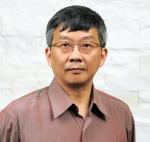Promotion of CO Oxidation on Bimetallic Au-Ag(110) Surfaces: A Combined Microscopic and Theoretical Study
- Citation:
- Chou, J. P., Pai W. W., Kuo C. C., Lee J. D., Lin C. H., & Wei C. M. (2009). Promotion of CO Oxidation on Bimetallic Au-Ag(110) Surfaces: A Combined Microscopic and Theoretical Study. Journal of Physical Chemistry C. 113, 13151-13159., Jul, Number 30
Abstract:
The clean-off reaction of AgO added rows by CO on Ag(110) and Au/Ag(110) bimetallic surfaces was studied by scanning tunneling microscopy (STM) and compared with density functional theory (DFT). This combined study of a model system illustrated the complexity of catalytic enhancement in bimetallic systems. By analyzing in situ time-lapsed STM image series, we found that CO oxidation on a Au-enriched Ag(110) surface leads to an exponential depletion of oxygen with time and a reaction rate that is synergistically enhanced by the presence of Au. First principles calculations indicate that the local atomic configuration around the active reaction sites at the chain ends and the preference of An atom substitution into the subsurface second Ag layer are of critical importance. By calculating CO adsorption energies and reaction barriers for plausible reaction pathways, a detailed description of the CO oxidation reaction emerges, For the optimal reaction pathway, a large (similar to 0.09 eV) barrier reduction and a small barrier of similar to 0.01 eV were found for the Eley-Rideal (ER) mechanism. In contrast, a small (similar to 0.03 eV) barrier reduction and a moderate barrier of similar to 0.23 eV were obtained for the Langmuir-Hinshelwood (LH) mechanism. The ER transitional state was also found to be lower in energy. We conclude that, irrespective of whether the ER mechanism is actually rate dominating, it is definitively enhanced.
Notes:
ISI Document Delivery No.: 473TZTimes Cited: 6Cited Reference Count: 48Cited References: Baxter RJ, 2002, J CHEM PHYS, V116, P4379, DOI 10.1063/1.1458938 BOWKER M, 1980, SURF SCI, V92, P528, DOI 10.1016/0039-6028(80)90221-6 Burgel C, 2008, J AM CHEM SOC, V130, P1694, DOI 10.1021/ja0768542 Burghaus U, 1997, SURF SCI, V370, P17, DOI 10.1016/S0039-6028(96)00929-6 Burghaus U, 1996, SURF SCI, V352, P201, DOI 10.1016/0039-6028(95)01131-5 CAMPBELL CT, 1990, ANNU REV PHYS CHEM, V41, P775, DOI 10.1146/annurev.physchem.41.1.775 CHAN CT, 1992, PHYS REV LETT, V69, P1672, DOI 10.1103/PhysRevLett.69.1672 Chan YL, 2004, J PHYS CHEM B, V108, P815, DOI 10.1021/jp036917c Chang CM, 2008, J CHEM PHYS, V128, DOI 10.1063/1.2841364 Derry GN, 2004, SURF SCI, V566, P862, DOI 10.1016/j.susc.2004.06.022 ENGELHARDT HA, 1976, SURF SCI, V57, P591, DOI 10.1016/0039-6028(76)90350-2 ERTL G, 1994, SURF SCI, V299, P742, DOI 10.1016/0039-6028(94)90694-7 Ferrando R, 2008, CHEM REV, V108, P845, DOI 10.1021/cr040090g Friedrich KA, 2000, ELECTROCHIM ACTA, V45, P3283, DOI 10.1016/S0013-4686(00)00430-8 Gottfried JM, 2002, SURF SCI, V511, P65, DOI 10.1016/S0039-6028(02)01555-8 Grob A, 2006, TOP CATAL, V37, P29 HAFTEL MI, 1994, PHYS REV LETT, V72, P1858, DOI 10.1103/PhysRevLett.72.1858 Hayoz J, 1999, PHYS REV B, V59, P15975, DOI 10.1103/PhysRevB.59.15975 Hayoz J, 1999, SURF SCI, V433, P104, DOI 10.1016/S0039-6028(99)00081-3 HIRSCHORN ES, 1995, SURF SCI, V323, pL299, DOI 10.1016/0039-6028(94)00750-0 HOHENBERG P, 1964, PHYS REV B, V136, pB864, DOI 10.1103/PhysRev.136.B864 JOOS B, 1991, PHYS REV B, V43, P8153, DOI 10.1103/PhysRevB.43.8153 KOHN W, 1965, PHYS REV, V140, P1133 Kondarides DI, 1996, J CATAL, V158, P363, DOI 10.1006/jcat.1996.0038 Kresse G, 1996, COMP MATER SCI, V6, P15, DOI 10.1016/0927-0256(96)00008-0 Landon P, 2003, PHYS CHEM CHEM PHYS, V5, P1917, DOI 10.1039/b211338b Liu JH, 2005, J PHYS CHEM B, V109, P40, DOI 10.1021/jp044938g MILS G, 1995, SURF SCI, V324, P305 Muller S, 2003, J PHYS-CONDENS MAT, V15, pR1429 Nakagoe O, 2005, J PHYS CHEM B, V109, P14536, DOI 10.1021/jp0512154 Nakagoe O, 2003, PHYS REV LETT, V90, DOI 10.1103/PhysRevLett.90.226105 Norskov JK, 2002, J CATAL, V209, P275, DOI 10.1006/jcat.2002.3615 OZCOMERT JS, 1994, PHYS REV LETT, V72, P258, DOI 10.1103/PhysRevLett.72.258 Pai WW, 1996, PHYS REV B, V53, P15997, DOI 10.1103/PhysRevB.53.15997 PERDEW JP, 1992, PHYS REV B, V46, P6671, DOI 10.1103/PhysRevB.46.6671 RODRIGUEZ JA, 1996, SURF SCI REP, V24, P123 Rodriguez JA, 1995, ACCOUNTS CHEM RES, V28, P477, DOI 10.1021/ar00060a001 Rodriguez JA, 2006, PROG SURF SCI, V81, P141, DOI 10.1016/j.progsurf.2006.02.001 RODRIGUEZ JA, 1992, SCIENCE, V257, P897, DOI 10.1126/science.257.5072.897 ROUSSET S, 1992, PHYS REV LETT, V69, P3200, DOI 10.1103/PhysRevLett.69.3200 SCHIMIZU T, 1993, SURF SCI, V295, pL1017 SINFELT JH, 1987, ACCOUNTS CHEM RES, V20, P134, DOI 10.1021/ar00136a002 Takanabe K, 2005, J CATAL, V232, P268, DOI 10.1016/j.jcat.2005.03.011 VATTUONE L, 1994, J CHEM PHYS, V101, P713, DOI 10.1063/1.468127 Wang AQ, 2005, J CATAL, V233, P186, DOI 10.1016/j.jcat.2005.04.028 Wang AQ, 2005, J PHYS CHEM B, V109, P18860, DOI 10.1021/jp051530q WANG Y, 1991, PHYS REV B, V44, P13298, DOI 10.1103/PhysRevB.44.13298 Wintterlin J, 1997, SCIENCE, V278, P1931, DOI 10.1126/science.278.5345.1931Chou, Jyh-Pin Pai, Woei Wu Kuo, Ching-Chang Lee, Jian Der Lin, Chien Hong Wei, Ching-MingNSC-TaiwanThe research was supported by NSC-Taiwan. We are grateful to the computing centers of Academia Sinica and National Taiwan University for providing computation resources. We thank Prof. K. C. Lin and Prof. C. Y. Mou for useful discussion.AMER CHEMICAL SOCWASHINGTON

